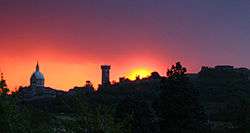Lonato del Garda
| Lonato del Garda | |
|---|---|
| Comune | |
| Città di Lonato del Garda | |
|
Lonato at sunset | |
 Lonato del Garda Location of Lonato del Garda in Italy | |
| Coordinates: 45°28′N 10°29′E / 45.467°N 10.483°ECoordinates: 45°28′N 10°29′E / 45.467°N 10.483°E | |
| Country | Italy |
| Region | Lombardy |
| Province / Metropolitan city | Brescia (BS) |
| Frazioni | Esenta, Sedena, Malocco, Castelvenzago, Campagna, Barcuzzi, Lido, Madonna della Scoperta, Centenaro |
| Government | |
| • Mayor | Roberto Tardani |
| Area | |
| • Total | 70 km2 (30 sq mi) |
| Elevation | 170 m (560 ft) |
| Population (2011)[1] | |
| • Total | 15,919 |
| • Density | 230/km2 (590/sq mi) |
| Demonym(s) | Lonatesi |
| Time zone | CET (UTC+1) |
| • Summer (DST) | CEST (UTC+2) |
| Postal code | 25017 |
| Dialing code | 030 |
| Patron saint | John the Baptist |
| Saint day | 24 June |
| Website | Official website |
Lonato del Garda (before 1 July 2007 Lonato; Lombard: Lunà) is a town and comune in the province of Brescia, in Lombardy, Italy. Lonato is located in the middle of northern Italy, about halfway between Milan and Venice, on the southwest shore of Lake Garda, the biggest lake in Italy.
Neighbouring communes are Castiglione delle Stiviere, Desenzano del Garda, Calcinato, Bedizzole, Calvagese della Riviera, Padenghe sul Garda, Pozzolengo, Montichiari, Solferino. The town is a holiday destination due to its scenic lakeside location about 5 kilometres (3 mi) from the lake) and its numerous historical and artistic monuments and museums, prehistoric sites (pile dwellings), Roman ruins, Medieval castle, Baroque churches and modern museums.
History
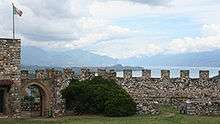
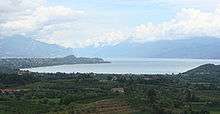
The town lies on the landscape of Morenic Hill, on the southwest side of Lake Garda. Here the first human settlements appeared in the Bronze Age on pile dwellings, as testified by archaeological findings in the areas of Polada and Lavagnone. The name Lonato is believed from some scholars to derive from the Celtic term “Lona” meaning little lake.
In the imperial Roman time, Lonato was crossed by the Basilica Emilia way, which used to connect Gallia with Aquileia. Roman ruins were found in the area of Monte Mario and Pozzo (Waiting for Godot).
The town was destroyed in the year 909 by the Hungarians, after which a new castle was built and the town fortified. In the following centuries Lonato was destroyed and rebuilt various times. In 1512 King Louis XII of France established his headquarters here when he invaded Italy. In 1516 Lonato become part of the Venetian Republic, until Napoleon arrived in 1796, when he fought and beat the Austrians during the first Italian campaign. In 1859 the town was part of the Italian Kingdom. During World War I the “basso Garda” defensive line was built, while in World War II it was a training centre for the X MAS.
The coat of arm is a lion rampant turned on the left side, with two golden keys grasped by the front legs. In 1509, King Louis XII of France granted to Lonato the honour to enrich the coat of arm with the three lilies of France, in gratitude for the favors that Lonato’s community offered him.
Lonato received the honorary title of city with a presidential decree on November 21, 1996.
Main sights
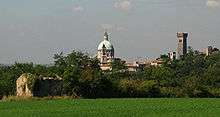
In the center of the town there is the Castle, called the Rocca of Lonato, which is about 1000 years old, with an ornithological museum, the House of the Podestà with a library, which has about 52,000 ancient books. About 10,000 visitors a year go to these sites, which are run by the Foundation Ugo da Como.[2]
Around the main square, called Piazza Martiri della libertà, there is the town hall, the Venetian column, the Cathedral of San Giovanni Battista, and the Civic Tower (or Clock Tower).
Outside the centre of town there are Roman ruins of Fornaci, the Abbazia di Maguzzano, Drugolo Castle, the churches of Madonna di San Martino, San Cipriano, and pieve di San Zeno.

The House of the Podestà was built in the second half of the 15th century as seat of the representative of Venetian Republic, who controlled the region for more than 350 years (1441-1796). Only briefly, was Lonato under Mantuan rule under Francesco II Gonzaga, Marquess of Mantua (1509–1516).
After Napoleon Bonaparte granted Venetian domains to the Austrians, the Podestà was used by Austrians as a barracks, and then to the commune of Lonato, under whom it fell into disrepair.
The building was auctioned in public in 1906, and bought by Ugo da Como and his wife Maria Glisenti, who, conscious of the historical importance, called the architect A. Tagliaferri (1835–1909) to restore it. As was fashionable in his time, they furnished the house, and today the extensive collections, including the library, 405 incunabola (one of the most important collection in Italy), 470 manuscripts and rare illuminated codes, parchments and prints. It also contains one of the smallest books in the world, 15x9 mm, which reproduces the letter by Galileo Galilei to Cristina di Lorena. In addition, it holds manuscripts letters by Ugo Foscolo to his lover Marzia Martinengo, written in 1807-1809.
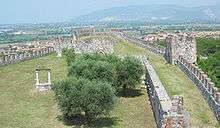
The Rocca of Lonato surmounts a hill dominating the southern side of Lake Garda. The southern slope shelters the historical centre of Lonato, the limits of which, today, borders the Padana lowlands.
The fortification's irregular form reveals a central structure almost 180 meters in length and approximately 45 metres in width. It is composed of two structures at different levels: the Rocca in the upper part and, lower down, what is called the General Quarters. Despite the long domination by the Visconti and Scaligeri families, the walled embankment, built in large morenic rocks, carries Guelph merlons.
In all probability, Lonato's castle was first built around the year 1000 when fortifications were raised around the area against the invasion of the barbarians. Its architectural design closely follows the standards of the 15th and 16th centuries when it was rebuilt by the Visconti family of Milan.
After passing from the Gonzaga domination to Venice, then back to the Gonzaga and again to Venice, the castle passed to the Austrian Empire and finally to private hands. The military base was demolished and the internal and external surface was transformed into agricultural land. In 1912 the castle was declared a national monument; it was bought by Senator Ugo da Como in 1920 who partly restored it, and since 1996 it houses the Museo Civico Ornitologico, conferences, weddings and theatral shows.
The Museo Civico Ornitologico (Museum of Birds) is located inside the castle and contains more than 700 specimens. The species represented are from the area of Lake Garda but also of exotic origin, together with specimens with rarities, unique characteristics, plumage anomalies.
The Duomo (Cathedral) of San Giovanni Battista (St. John the Baptist) dates from the 19th century. It is an example of Baroque architecture, designed by the Lonato architect Paolo Sorattini (1680–1762) and built during the second half of the 18th century. Its balanced cupola (20 meters of diameter and 60 meters high) and facade soberly decorated with marble are the basilica's most notable points. The magnificent baroque interior is enriched with frescoes and altar pieces by Venetian artists such as Antonio Balestra and Giambettino Cignaroli.
The civic tower (1555) is 55 metres (180 ft) high and it has a clock of the 1773 with very interesting counterbalance mechanism.

Fornaci Romane is a Roman site south of Lonato in Gorghi. Six Roman brickworks were recently found and restored. The brickworks have circular shape with a firing chamber built using a technique with casts of pebbles stuck together with mortar. The ruins seems to indicate that this location was an important industrial center between the 1st and 2nd century AD.
Municipal administration
Since 1996 (under the new electoral law, 1993) the mayor of Lonato is directly elected by the population and the election occurs without ballot because the commune hasn't a population higher than 15.000 inhabitants.
The City Council of Lonato has 20 members. The current mayor of Lonato is Mario Bocchio (Lega Nord), elected for the first time in 2005 and re-elected on 30 March 2010 with the 56% of the votes.[3]
Fairs and markets

- "Mercantico": antiquity market, every 3rd week of the month, in the center of the town
- Local market: every Thursday morning, in the center of the town
- Town Fair: "Fiera di Lonato", January 17 (every year)
Transportation
By car: A4 motorway, take Desenzano exit; from the A22 motorway: in northern Verona take the direction Brescia-Milano (Brescia-Milan), and exit at Desenzano del Garda
By airplane: the closest airports are in order
- Brescia Airport (VBS)
- Orio al Serio International Airport (BGY)
- Villafranca-Verona Airport (VRN)
- Milan Malpensa International Airport (MPX)
- Milan Linate Airport (LIN)
Notable residents
- Vittorio Barzoni (1767–1843)
- Luigi Cerebotani (1847–1928)
- Reginald Pole (1500–1558)
- Paolo Soratini (1682–1762)
- Camillo Tarello (ca. 1513–1573) agronomist
- Roberto Vecchioni (born 1943)
External links
- Website of the Fondation Ugo da Como
- Lonato Turism Website (italian)
- La Polada (italian)
- Brescia Transports
Sources
- ↑ "ISTAT". demo.istat.it. Retrieved 30 September 2016.
- ↑ "Fondazione Ugo Da Como". www.fondazioneugodacomo.it. Retrieved 30 September 2016.
- ↑ "::: Ministero dell'Interno ::: Archivio Storico delle Elezioni - Comunali". elezionistorico.interno.it. Retrieved 30 September 2016.
